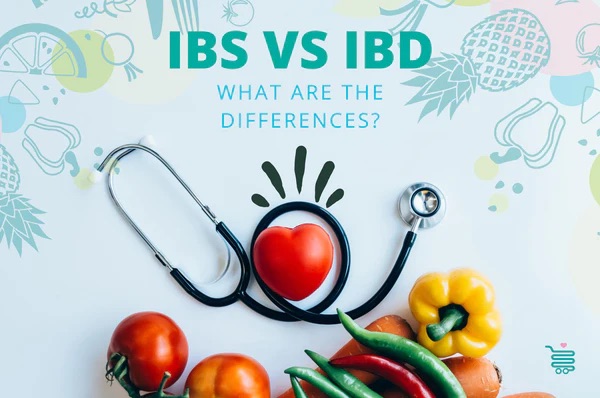When it comes to the world of gastrointestinal diseases, you may hear a lot of acronyms, such as IBD and IBS. Inflammatory bowel disease (IBD) is a broad term that refers to chronic swelling (inflammation) of the intestines.
Inflammatory bowel disease is often confused with the noninflammatory condition irritable bowel syndrome (IBS).
Although the two disorders share similar names and some of the same symptoms, they have key differences. Read on to learn what distinguishes IBD and IBS.
IBD and IBS are distinctly different conditions. Still, a person who has been diagnosed with one may display symptoms of the other. It’s also important to know that you can have both conditions at the same time. Both are considered chronic (ongoing) conditions.
Although both conditions can occur in anyone at any age, they seem to run in families.
What is IBD?
Inflammatory bowel disease (IBD) is a term for a group of disorders characterized by prolonged inflammation in various parts of the digestive tract. The most common form of IBD is ulcerative colitis.
The two main conditions that are classified as IBD are:
- Ulcerative colitis (UC). A lifelong condition that’s characterized by recurring episodes of inflammation in the mucosal layer of the colon. It commonly involves the rectum and may extend to other parts of the colon.
- Crohn’s disease (CD). CD can affect any part of your gastrointestinal (GI) tract, from your mouth to your anus. Symptoms of Crohn’s disease may also include diarrhea, abdominal cramps, and fever.
Another form of IBD, indeterminate colitis, is diagnosed when tests cannot at first distinguish which form of IBD it is. Most cases of indeterminate colitis eventually evolve to a diagnosis of either CD or UC.
For both of these conditions, no cure is currently available, but they can be managed with medication.
What is IBS?
Irritable bowel syndrome (IBS) is a chronic functional disorder of the gastrointestinal tract, characterized by chronic abdominal pain and altered bowel habits. People with IBS show no clinical signs of a disease and often have normal test results.
IBS has physical symptoms, but the causes aren‘t currently well understood. Researchers are currently looking into some potential causes, such as:
- food intolerances (such as fructose, lactose, sucrose, or gluten)
- a reaction from a previous infection
- bacterial overgrowth
- stress
Depending on the main symptoms, people with IBS receive a diagnosis of one of three classifications:
- IBS with constipation (IBS-C)
- IBS with diarrhea (IBS-D)
- IBS-mixed (IBS-M)
Sometimes, IBS symptoms are called mucous colitis or spastic colitis, but those names are technically incorrect. Colitis is an inflammation of the colon, and IBS does not cause inflammation.
Abdominal pain is a common symptom of both IBS and IBD. With IBD, you may experience pain in other parts of your body, too.
IBS pain
Abdominal pain is the most common symptom reported by people with IBS. Research shows 3 out of 4 people with IBS report either continuous or frequent abdominal pain.
The pain is most often felt in the lower abdomen, though it can occur anywhere in the belly. The type and severity of pain can vary, even within a single day. Types and locations of IBS pain often include:
- Upper abdomen pain may get worse after eating and is often accompanied by bloating.
- Middle abdomen pain centers in the belly area and is often felt as cramping.
- Lower abdomen pain usually decreases after a bowel movement.
People with IBS also report different types of pain, including:
- cramping
- sharp, or stabbing
- aching
- throbbing
Pain associated with IBS includes both visceral pain, meaning it originates in bodily organs, and functional pain, which does not have a known bodily source and is not accounted for by any test.
Because its symptoms involve functional pain, IBS is sometimes categorized as a centralized sensitivity syndrome (CSS). These are groups of conditions that involve a heightened experience of pain, as in fibromyalgia and chronic fatigue syndrome.
IBD pain
Abdominal pain is also a common symptom of IBD.
The Crohn’s & Colitis Foundation estimates that 50 to 70 percent of people with IBD report gastrointestinal (GI) pain when their IBD symptoms first began and, later, whenever the disease is active.
People also report pain associated with IBD in other parts of the body, such as:
- painful joints
- skin sensitivity
- eye discomfort
- oral sores
- pain around the rectum
IBS is extremely common. In fact, the International Foundation for Functional Gastrointestinal Disorders estimates that it affects up to 15 percent of the population worldwide.
The Centers for Disease Control and Prevention (CDC) reported that in 2015, 3 million adults in the United States, or 1.3 percent of the U.S. adult population, were diagnosed with IBD. This represented an increase of about 50 percent over the previous 6 years.
Diagnoses of IBS and IBD are very different. IBD is diagnosed through a variety of tests, whereas IBS is diagnosed largely by exclusion, or ruling out other diseases and conditions.
IBS
Doctors do not order tests to diagnose IBS, although they may use test results to rule out other conditions. Instead, an IBS diagnosis is usually made on the basis of:
- medical history
- family history
- physical exam
- symptom report
- ruling out other conditions
The Rome IV criteria form is the basis for diagnosing IBS.
These criteria say a diagnosis can be made only after a person has had symptoms at least 1 day per week over the last 3 months and having symptoms that began at least 6 months ago.
Since IBS symptoms primarily involve your bowel movements, a diagnosis takes this into account as well. The Rome IV criteria for an IBS diagnosis specify that two of the following conditions must be met:
- Your symptoms are related to defecation.
- The frequency of your stool has changed.
- The appearance of your stool has changed.
Often, an IBS diagnosis is made only after many other diseases and conditions are ruled out. Since testing for other conditions can be a lengthy process, your IBS diagnosis may sometimes take weeks or even months.
IBD
Diagnosis of IBD, unlike IBS, will require medical tests. Any of these tests may be used to diagnose IBD, as well as rule out other medical conditions:
- stool studies
- blood tests
- biopsy
- X-ray
- MRI scan
- CT Scan
- barium contrast study
Your doctor may also refer you for endoscopic evaluations, such as an esophagogastroscopy or colonoscopy, to evaluate the severity and extent of inflammation. These involve inserting a small tube with a camera into either the esophagus or the rectum.
During these exams, your doctor will likely collect tissue to biopsy to help differentiate between different types of IBD.
The exact causes of IBS and IBD are still the subject of clinical study. Genetics and family history are thought to play a part in both.
IBS
The cause of IBS is not known for certain, but the following conditions are thought to increase your risk:
- bacterial infections in the intestines or colon
- food intolerances and sensitivities
- genetics, with a family history of IBS
- mood disorders, such as depression and anxiety
IBD
The exact cause of IBD is not known. It’s thought that the main trigger is an immune system that does not operate as it should. Researchers now think that IBD arises through a combination of:
- genetics
- environmental factors, like stress
- the gut microbiota, or the microorganisms that live in the body
Normally, the immune system limits the effects of harmful bacteria, viruses, and environmental toxins. In a person with IBD, the immune system falters, and inflammation develops in the GI tract.
Researchers also think genetics play a part in causing IBD. People with a family history of either ulcerative colitis or Crohn’s disease are at greater risk of developing these diseases.
Stress is known to make all GI disorders feel worse. There is a lot of truth when we describe a reaction as “gut-wrenching.“ In fact, stress can have a lot of very real effects on the body.
IBS
Since the inflammation of IBD is absent in people with IBS, it’s difficult for researchers to understand the precise causes of IBS. But they do know that IBS is almost always exacerbated by stress.
Stress reduction techniques may help decrease your IBS symptoms. Consider trying:
- meditation
- regular exercise
- talk therapy
- yoga
IBD
Research shows that stress may affect both the onset of IBD and the course of the disease. In particular, it may aggravate the disease and contribute to the occurrence of flare-ups.
Stress may also intensify the mood disorders that sometimes arise in people living with the disease. Emotional disorders, such as depression and anxiety, are common among people with IBD, and stress can intensify their effects.
Both IBS and IBD can lead to complications, especially if left untreated. These conditions affect not only the digestive system but your mental health as well.
IBS complications
If left untreated, IBS can lead to a lower quality of life. You may miss days of work and feel reluctant to engage in activities for fear that pain or embarrassing side effects might arise at an inconvenient time.
IBS can involve other complications, such as:
- chronic diarrhea, which is sometimes a symptom of IBS, and can lead to hemorrhoids
- frequent bowel movements or cramps that can disrupt daily activities
- mood disorders such as depression and anxiety
IBD complications
Symptoms of IBD may escalate to conditions that require medical attention. Ulcerative colitis and Crohn’s disease, the two main forms of IBD, have different potential complications. These complications can occur quickly. If they do, you will need to seek immediate medical help.
For ulcerative colitis, complications might include
- a perforated bowel, in which the chronic inflammation creates a hole in your bowel
- rapid enlargement of your colon, which is called a toxic megacolon
- severe diarrhea
- rectal bleeding and pain
Complications of Crohn’s disease can include:
- abscesses
- strictures, or intestinal blockages
- perforated bowel
- fistulas, abnormal connections that develop between tissues or body parts and need to be managed for potential infection
- malabsorption of food, leading to malnutrition
Complications of IBD can also develop outside the GI tract. For example, disorders may develop in other parts of the body, such as the skin, kidneys, or joints.
Treatments for IBS and IBD vary based on severity. While IBS often responds well to lifestyle changes and avoiding triggers, IBD treatment is typically more complex.
IBS
IBS may be treated with certain medications such as intestinal antispasmodics like hyoscyamine (Levsin) or dicyclomine (Bentyl).
Dietary and lifestyle changes that seem to help the most include:
- avoiding fried and fatty foods and caffeinated beverages
- relaxation practices, such as meditation and yoga
- psychotherapy to help reduce your overall stress
- a heating pad to help ease cramping and pain
- acupuncture
- herbal remedies, such as chamomile tea
- probiotics
IBD
IBD treatment depends on the form diagnosed. The primary goal is treating and preventing inflammation that, over time, can damage the intestines. Common treatment options for IBD can include:
- corticosteroids
- 5-ASA drugs (aminosalicylates)
- immunomodulators
- biologics
- surgery
- dietary changes that avoid trigger foods
Treatment for IBD can be complex, so your gastroenterologist can help you create the right treatment plan for your needs.
The first line of treatment for IBD is usually medication. Natural remedies should only supplement your existing treatment plan with your doctor’s permission and supervision, and they may not be effective.
However, psychotherapy is said to be especially helpful, as the anxiety that IBD can trigger can make symptoms worse. Learning to calm mood disturbances can make your IBD symptoms calmer, too.
IBD and IBS may seem to share similar symptoms, but they are two different conditions with very different treatment requirements.
With IBD, the goal is to reduce inflammation that causes symptoms. IBS, on the other hand, may not be treatable with medications because there’s not an identifiable bodily cause.
Research is ongoing in an effort to develop more effective treatments. There are ways to manage your symptoms so you can have a good quality of life.
A gastroenterologist can help determine your specific condition and offer the best treatment plan and resources to help you manage your symptoms.













